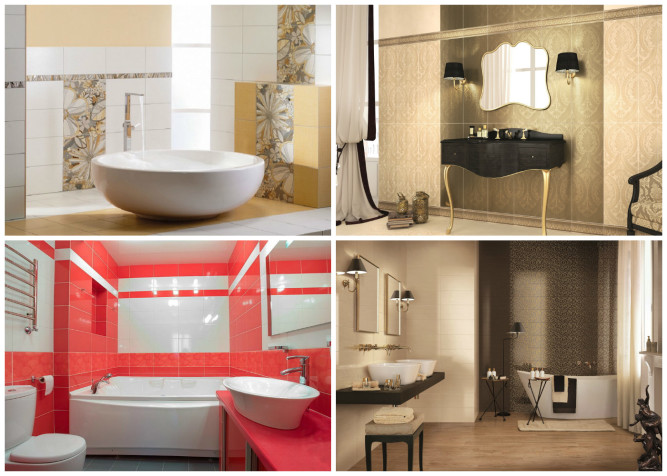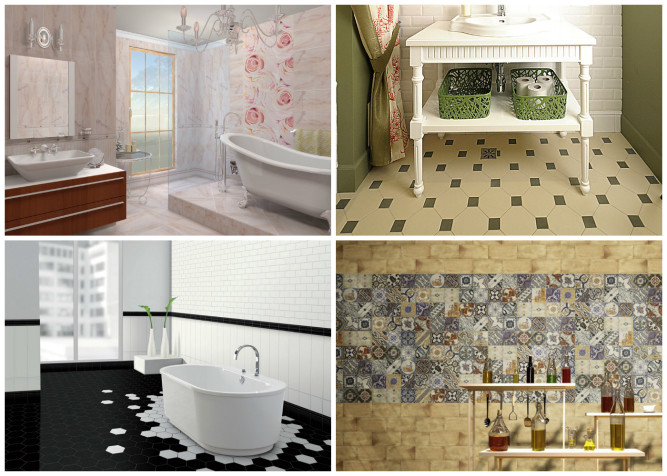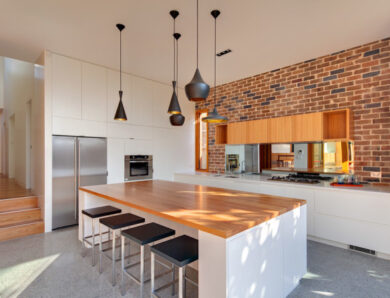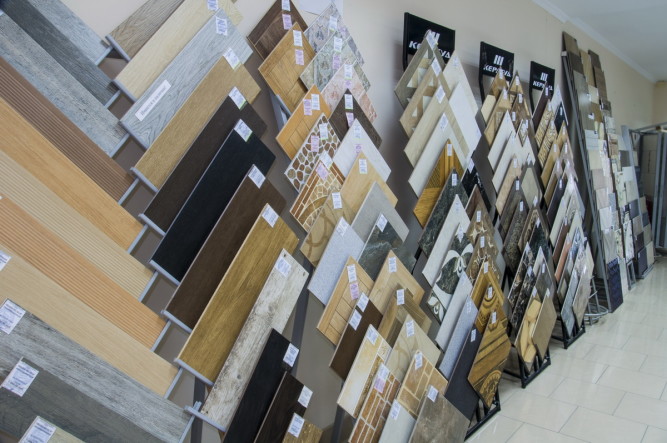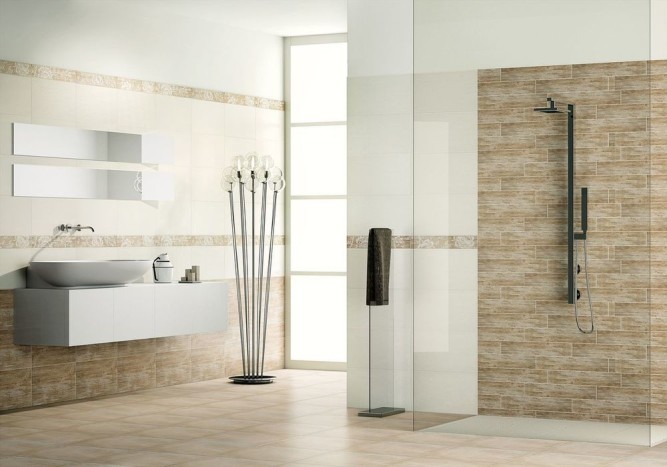
Tile layout: options and methods of laying
When creating a new interior, example, bathroom or kitchen, tile layout is important. Much depends on the scheme, including the final cost of material. There are several standard ways for each type of product, as well as extraordinary, require practical skills in working with tiles and accuracy. To better understand what we are talking about, consider popular methods in detail.
Combining the elements of the cladding allows you to create a unique image of the room
Influence of the scheme on the interior
Tile layout often plays a key role in design. Here are some key areas in this regard:
- External perception. It is important to achieve an aesthetic appearance of the finished surface. The chosen scheme should correspond to the type of the purchased tile.
- Unique design. Using different types of products, experimenting with their condition and ratio, a new interior design is created, even from the most common tile samples.
- Consumption of tiles. A simple layout saves material, but it is less interesting visually. More complex schemes require more money, additional processing of tiles and purchase of auxiliary parts.
- Visual effects. Some techniques visually expand the space or create the appearance of an optical illusion.
With the help of tile layout schemes, different goals are achieved: zone selection, expansion of space, arrangement of accents, etc.. P.
That in the course of repair there was something to start from, consider, frequently used options. These include the following schemes:
- straight;
- scattered;
- tree;
- diagonal.
Direct layout
The simplest options involve the most efficient use of cladding material and minimal installation costs. In this case, the tile is laid by the method of "seam to seam", that is, each row of the following repeats the position of the previous one.
Seam-to-seam layout
Thanks to such scheme of laying of a tile expenses to a minimum are reduced. Especially when the elements fill the facing area without the need for trimming. Even a beginner can handle such work.
Any type of tile is laid in a similar way. Most often, the direct scheme is used for square models, as well as standard wall cladding format 20x30 cm. Rectangular tiles also look good. In this way it is laid out horizontally, and vertically, depending on, what you want to achieve: visually expand the wall or raise the ceiling. This method often uses different color combinations: allocation of zones, formation of stripes, decorative frieze inserts, etc.. d.
Tile on the run
In this case, the displacement of each subsequent row on the floor-element. That is, the seams of adjacent tiles do not join, and fall in the middle of them.
Similar methods are relevant for rectangular elements. For wall covering - imitation of a bricklaying, and for floor - parquet or laminate. This is especially true, if the material reproduces the presented products.
Imitation brickwork on the walls and parquet flooring
The "run-in" scheme allows you to beat the facing surface more interestingly and has a positive visual effect.. With the help of such a calculation it is possible to increase the space due to the non-standard perception of the coating.
Of course, this method has disadvantages. We will have to work on cutting the tile, after all, at least half of the rows will inevitably begin and end with an incomplete element. in addition, follow a clear division of the tile in half, to make the masonry look neat and natural.
Scheme of a Christmas tree
This option is suitable for small rectangular products. It is based on joining the narrow side of the tile with the wide one, forming an angle in 90 degrees. This method is used to lay wooden parquet.
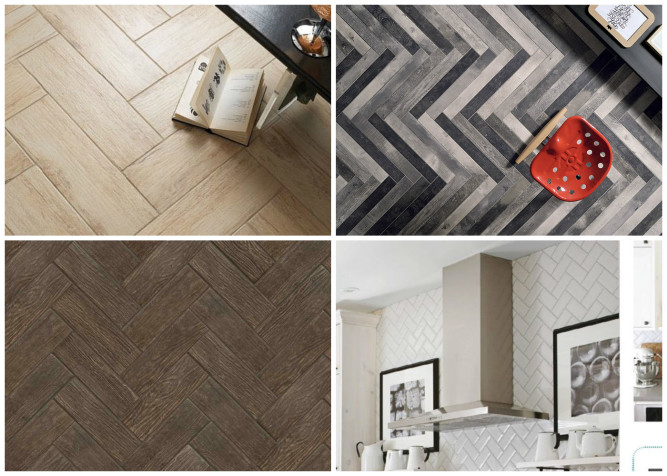
The advantages of such a layout:
- original appearance;
- visual expansion of space;
- relative ease of execution;
- possibility of imitation of a parquet covering.
Most often, this scheme is used for flooring, but on the walls it also looks very interesting
There are three types of Christmas tree layouts:
- Single. Each subsequent element joins the next. This is a standard option.
- Double. When forming a series, a pair of rectangular fragments is used.
- Triple. Accordingly used 3 element. In appearance, this design resembles weaving.
Depending on the format of the tile, the scheme of laying a Christmas tree looks different. If the difference in the length of the sides is sufficient, the design looks brighter. At a proportional ratio 1:2 such stacking rather resembles a zigzag.
Diagonal
No variant can be compared in originality and functionality with a diagonal layout. This method is equally suitable for square, and with rectangular tiles. With its help visually spread the walls and increase the area. Therefore, it is often used in the design of small rooms.
Visual expansion of space
Note, that diagonal laying of a tile is mainly used in a floor covering. However, it also applies to walls, but it is not easy to do. In any case, you need skills to work with tiles.
To prevent material shortages, such types of laying involve the purchase of tiles in stock. This is due to the need to trim a large number of elements, and also with risk of damage of facing at its sawing.
This method is most acceptable in small rooms, but in large areas it will look quite interesting and advantageous. It is better for inexperienced home craftsmen to hire specialists in order to implement such an idea, this will speed up the repair process and will not cause unnecessary costs.
Use of various format products
The most difficult, but the most decorative option - the use of several models of tiles. This is not about color or texture, and directly about the format. Methods of laying ceramic tiles of different sizes and shapes are almost unlimited.
A popular option is to use combinations of rectangular and small square elements. Also relevant is the combination of small and large squares. With the help of such products create a tile layout, which turns a boring cover into an interesting picture. It can be like a chess ornament, strip frame or just a geometric pattern in any area of the cladding.
Interiors with different format tiles and decorated fragments
This work uses the most incredible types of tiles. Complex configurations are often used, example, hexagons. The standard scheme of running is supplemented with halves of ordinary tiles. You do not have to buy special material, to add zest to the interior, try to start from the already available funds.
The main criterion, which establishes the principle of tile layout, is a fantasy designer. Even the simplest way turns into an interesting solution, if you experiment with existing tiles. Try drawing pre-available diagrams or lay tiles on the floor to clearly evaluate the options..


